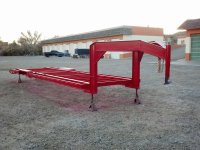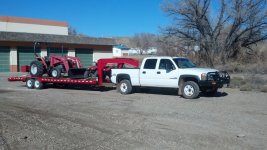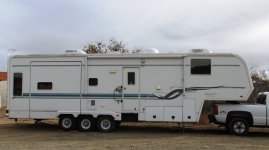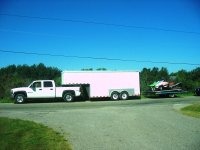It's not really a concern to hit the cab with most farm-type trailers, as you would need to be well beyond 90deg to the trailer.
See how the trailer narrows to the hitch?

So the concern with this type of trailer is that if the hitch frame is not high enough, the bed sides or tailgate can contact it going over uneven terrain, and cause damage. I made my trailer with about 12" of clearance to the bed rails for this reason.

Gooseneck hitches are not used on factory built camper trailers (caravans), but the 5th wheel hitch location is similar, at generally 4-6" ahead of the rear axle in the middle of the bed. Cab clearance when turning can be a problem if the front of the camper is wide and the truck has a short bed. My "home" is this type of trailer, and because I have a short bed truck, I must be careful when turning sharp. I have lightly dented one side of the cab already!


Because shorter truck boxes are becoming "standard" here these days, many modern campers have a tapered front to prevent this concern. There are also 5th wheel hitches available that can slide back to provide more clearance for tight turning.
I also have an enclosed cargo trailer, which is gooseneck. It is also older, and made for a long bed truck. I must be careful because this trailer is not designed with much clearance to the bed rails OR to the cab. If I turn sharp, the front corners WILL break out the back window!! This trailer also has contacted the tailgate lightly, and when a friend borrowed it, dented one of the bed sides when he slid off his driveway because of ice.

There are a few "concerns" when towing a gooseneck or 5th wheel vs. bumper tow...
First is a good one: A bumper tow trailer with too little tongue weight will become unstable at higher speeds and begin swaying. If the trailer is heavy enough, the sway can become bad enough to drag the tow vehicle around, and cause a crash. (I call that "going for a trailer ride") Because the hitch location is slightly in front of the the rear axle, a gooseneck has very little ability to sway the tow vehicle. The design of gooseneck/5th wheel trailers is also such that it is VERY difficult to load the trailer to have light tongue weight. We loaded a gooseneck very badly, to negative tongue weight (pulling UP on the hitch) when I worked at TRW Automotive. We wanted it to sway to test our trailer sway control logic that was being developed. We were unsuccessful getting the gooseneck to sway.
The not so good concerns are related. Because the hitch is forward of the rear axle, the trailer tracks further to the inside of a turn than a similar length bumper tow trailer. It is easy to curb a gooseneck, or wipe out stop signs when turning. The hitch location also slows trailer response to steering input when backing, as you don't get the over-steer effect of having the pivot point well behind the rear axle, as with a bumper tow. I find gooseneck trailers more stable when backing at higher speeds, but less maneuverable in tight quarters. Because I mostly grew up towing from the bumper, I am not as good at backing up a gooseneck yet if I need it to turn into position.
Hopefully this helps!





